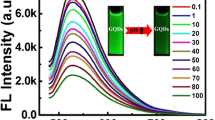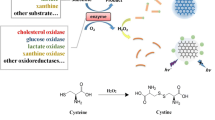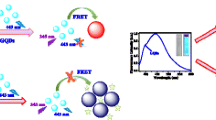Abstract
The authors describe a non-enzymatioc glucose assay that has three features: (a) The use of a boronic acid as the recognition element; (b) the aggregation of gold nanoparticles (AuNPs), and (c) the use of graphene oxide quantum dots (GOQD) whose fluorescence matches the absorption of the AuNPs and thereby results in an inner filter effect (IFE). The GOQD display an orange colored fluorescence that is filtered off by the AuNPs due to an IFE. In the presence of 3-aminobenzeneboronic acid, glucose is bound to form a cationic species that causes the aggregation of AuNPs to form large assemblies. This is accompanied by a color change from red to blue, and the IFE no longer does occur so that the orange fluorescence of the GOQD pops up again. These findings were used to design an assay witha linear response in the 2.5 to 75 μmol L−1 glucose concentration range, with a detection limit of 0.65 μmol L−1. The method was applied to the determination of glucose in spiked diluted serum and gave satisfactory results.

Schematic of the detection of glucose based on inner filter effect of dispersed AuNPs on the orange fluorescence of graphene oxide quantum dots.





Similar content being viewed by others
References
Yang J, Cho M, Lee Y (2016) Synthesis of hierarchical Ni(OH)(2) hollow nanorod via chemical bath deposition and its glucose sensing performance. Sensors Actuators B Chem 222:674–681
Yu Z, Li H, Zhang X, Liu N, Tan W, Zhang X, Zhang L (2016) Facile synthesis of NiCo2O4@polyaniline core-shell nanocomposite for sensitive determination of glucose. Biosens Bioelectron 75:161–165
Chen J, Ge J, Zhang L, Li Z, Qu L (2016) Poly(styrene sulfonate) and Pt bifunctionalized graphene nanosheets as an artificial enzyme to construct a colorimetric chemosensor for highly sensitive glucose detection. Sensors Actuators B Chem 233:438–444
Steiner M-S, Duerkop A, Wolfbeis OS (2011) Optical methods for sensing glucose. Chem Soc Rev 40(9):4805–4839
Fan Y, Tan X, Liu X, Ou X, Chen S, Wei S (2015) A novel non-enzymatic electrochemiluminescence sensor for the detection of glucose based on the competitive reaction between glucose and phenoxy dextran for concanavalin a binding sites. Electrochim Acta 180:471–478
Gao ZF, Chen DM, Lei JL, Luo HQ, Li NB (2015) A regenerated electrochemical biosensor for label-free detection of glucose and urea based on conformational switch of i-motif oligonucleotide probe. Anal Chim Acta 897:10–16
Fang X, Wu X-M, Hu X-L, Li Z-J, Wang G-L (2016) Native carbon nanodots as a fluorescent probe for assays based on the use of glucose oxidase or horseradish peroxidase. Microchim Acta 183(10):2761–2770
Durán GM, Benavidez TE, Ríos Á, García CD (2016) Quantum dot-modified paper-based assay for glucose screening. Microchim Acta 183(2):611–616
Sodzel D, Khranovskyy V, Beni V, Turner APF, Viter R, Eriksson MO, Holtz P-O, Janot J-M, Bechelany M, Balme S, Smyntyna V, Kolesneva E, Dubovskaya L, Volotovski I, Ubelis A, Yakimova R (2015) Continuous sensing of hydrogen peroxide and glucose via quenching of the UV and visible luminescence of ZnO nanoparticles. Microchim Acta 182(9):1819–1826
Ding C, Yan Y, Xiang D, Zhang C, Xian Y (2016) Magnetic Fe3S4 nanoparticles with peroxidase-like activity, and their use in a photometric enzymatic glucose assay. Microchim Acta 183(2):625–631
Çiftçi H, Alver E, Çelik F, Metin AÜ, Tamer U (2016) Non-enzymatic sensing of glucose using a glassy carbon electrode modified with gold nanoparticles coated with polyethyleneimine and 3-aminophenylboronic acid. Microchim Acta 183(4):1479–1486
Tan L, Chen K, Huang C, Peng R, Luo X, Yang R, Cheng Y, Tang Y (2015) A fluorescent turn-on detection scheme for α-fetoprotein using quantum dots placed in a boronate-modified molecularly imprinted polymer with high affinity for glycoproteins. Microchim Acta 182(15):2615–2622
Adolfsson KH, Hassanzadeh S, Hakkarainen M (2015) Valorization of cellulose and waste paper to graphene oxide quantum dots. RSC Adv 5(34):26550–26558
He Y, Sun J, Feng D, Chen H, Gao F, Wang L (2015) Graphene quantum dots: highly active bifunctional nanoprobes for nonenzymatic photoluminescence detection of hydroquinone. Biosens Bioelectron 74:418–422
Du X, Jiang D, Liu Q, Zhu G, Mao H, Wang K (2015) Fabrication of graphene oxide decorated with nitrogen-doped graphene quantum dots and its enhanced electrochemiluminescence for ultrasensitive detection of pentachlorophenol. Analyst 140(4):1253–1259.S
Benitez-Martinez S, Valcarcel M (2015) Fluorescent determination of graphene quantum dots in water samples. Anal Chim Acta 896:78–84
Zhang L, Peng D, Liang R-P, Qiu J-D (2015) Graphene quantum dots assembled with Metalloporphyrins for "turn on" sensing of hydrogen peroxide and glucose. Chem Eur J 21(26):9343–9348
Pei H, Zhu S, Yang M, Kong R, Zheng Y, Qu F (2015) Graphene oxide quantum dots@silver core-shell nanocrystals as turn-on fluorescent nanoprobe for ultrasensitive detection of prostate specific antigen. Biosens Bioelectron 74:909–914
Abnous K, Danesh NM, Ramezani M, Emrani AS, Taghdisi SM (2016) A novel colorimetric sandwich aptasensor based on an indirect competitive enzyme-free method for ultrasensitive detection of chloramphenicol. Biosens Bioelectron 78:80–86
Xianyu Y, Xie Y, Wang N, Wang Z, Jiang X (2015) A dispersion-dominated chromogenic strategy for colorimetric sensing of glutathione at the Nanomolar level using gold nanoparticles. Small 11(41):5510–5514
Xia N, Zhou B, Huang N, Jiang M, Zhang J, Liu L (2016) Visual and fluorescent assays for selective detection of beta-amyloid oligomers based on the inner filter effect of gold nanoparticles on the fluorescence of CdTe quantum dots. Biosens Bioelectron 85:625–632
Liu Z, Liu H, Wang L, Su X (2016) A label-free fluorescence biosensor for highly sensitive detection of lectin based on carboxymethyl chitosan-quantum dots and gold nanoparticles. Anal Chim Acta 932:88–97
Zhao W, Brook MA, Li Y (2008) Design of Gold Nanoparticle-Based Colorimetric Biosensing Assays. Chembiochem 9(15):2363–2371
Lou J, Liu S, Tu W, Dai Z (2015) Graphene Quantums dots combined with endonuclease cleavage and bidentate chelation for highly sensitive Electrochemiluminescent DNA Biosensing. Anal Chem 87(2):1145–1151
Song L, Shi J, Lu J, Lu C (2015) Structure observation of graphene quantum dots by single-layered formation in layered confinement space. Chem Sci 6(8):4846–4850
Vasu KS, Sridevi S, Sampath S, Sood AK (2015) Non-enzymatic electronic detection of glucose using aminophenylboronic acid functionalized reduced graphene oxide. Sensors Actuators B Chem 221:1209–1214
Qian S, Liang Y, Ma J, Zhang Y, Zhao J, Peng W (2015) Boronic acid modified fiber optic SPR sensor and its application in saccharide detection. Sensors Actuators B Chem 220:1217–1223
Cayuela A, Soriano ML, Valcarcel M (2015) Reusable sensor based on functionalized carbon dots for the detection of silver nanoparticles in cosmetics via inner filter effect. Anal Chim Acta 872:70–76
Wu Q, Wang X, Liao C, Wei Q, Wang Q (2015) Microgel coating of magnetic nanoparticles via bienzyme-mediated free-radical polymerization for colorimetric detection of glucose. Nanoscale 7(40):16578–16582
Xiong Y, Zhang Y, Rong P, Yang J, Wang W, Liu D (2015) A high-throughput colorimetric assay for glucose detection based on glucose oxidase-catalyzed enlargement of gold nanoparticles. Nanoscale 7(38):15584–15588
Wang Y, Zhang S, Bai W, Zheng J (2016) Layer-by-layer assembly of copper nanoparticles and manganese dioxide-multiwalled carbon nanotubes film: a new nonenzymatic electrochemical sensor for glucose. Talanta 149:211–216
Fang L, Liu B, Liu L, Li Y, Huang K, Zhang Q (2016) Direct electrochemistry of glucose oxidase immobilized on Au nanoparticles-functionalized 3D hierarchically ZnO nanostructures and its application to bioelectrochemical glucose sensor. Sensors Actuators B Chem 222:1096–1102
Qu F, Guo X, Liu D, Chen G, You J (2016) Dual-emission carbon nanodots as a ratiometric nanosensor for the detection of glucose and glucose oxidase. Sensors Actuators B Chem 233:320–327
Lerner MB, Kybert N, Mendoza R, Villechenon R, Bonilla Lopez MA, Charlie Johnson AT (2013) Scalable, non-invasive glucose sensor based on boronic acid functionalized carbon nanotube transistors. Appl Phys Lett 102(18):183113
Zhao YQ, Luo HQ, Li NB (2009) Electrochemical characterization of in situ functionalized gold p-aminothiophenol self-assembled monolayer with 4-formylphenylboronic acid for recognition of sugars. Sensors Actuators B Chem 137(2):722–726
Badhulika S, Tlili C, Mulchandani A (2014) Poly(3-aminophenylboronic acid)-functionalized carbon nanotubes-based chemiresistive sensors for detection of sugars. Analyst 139(12):3077–3082
Tang X, Zhang B, Xiao C, Zhou H, Wang X, He D (2016) Carbon nanotube template synthesis of hierarchical NiCoO2 composite for non-enzyme glucose detection. Sensors Actuators B Chem 222:232–239
Acknowledgements
This work was financially supported by the National Natural Science Foundation of China (Nos. 21075050 and 21275063), the Science and Technology Development project of Jilin province, China (No. 20150204010GX).
Author information
Authors and Affiliations
Corresponding author
Ethics declarations
The author(s) declare that they have no competing interests.
Electronic supplementary material
ESM 1
(DOC 6411 kb)
Rights and permissions
About this article
Cite this article
Na, W., Liu, H., Wang, M. et al. A boronic acid based glucose assay based on the suppression of the inner filter effect of gold nanoparticles on the orange fluorescence of graphene oxide quantum dots. Microchim Acta 184, 1463–1470 (2017). https://doi.org/10.1007/s00604-017-2090-x
Received:
Accepted:
Published:
Issue Date:
DOI: https://doi.org/10.1007/s00604-017-2090-x




